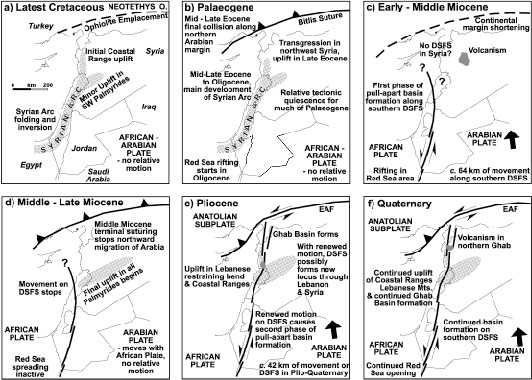Home | Results Summary | Publications | Participants | M.East / N.Africa Home
![]()
We examine the structure and evolution of the Ghab basin that formed on the active, yet poorly understood, northern segment of the Dead Sea transform fault system. The basin formed in Plio-Quaternary time at a complex step-over zone on the fault. Subsidence occurred along cross-basin and transform-parallel faults in two asymmetric depocentres. The larger depocentre in the south of the basin is asymmetric towards the east, the margin along which most active transform displacement apparently occurs. The Syrian Coastal Ranges, located directly west of the Ghab basin, are a consequence of Late Cretaceous and Cenozoic regional compression, heavily modified by the Dead Sea fault system and Ghab basin formation. We prefer a model whereby the Dead Sea fault system in northwest Syria developed in Plio-Quaternary time, consistent with previously proposed models of two-phase Dead Sea fault system movement and Red Sea spreading.
Key Figures and Captions
Figure 1. Shaded relief image of the area immediately surrounding the Ghab basin illuminated from the northwest. The very low relief Ghab basin is at an elevation of c.170 m, and the peak of the Coastal Ranges is 1562 m. Locations of other figures are shown. Seismic reflection profile locations are shown as thin black lines and well locations are illustrated with solid circles. (AP is Asharneh Plain, JW is Jebel Wastani, JZ is Jebel Az-Zawieh, BT is Balou Trough, MG is Missyf Graben). Location of the main figure is shown by heavy box in inset figure. Inset shows a shaded relief image of the eastern Mediterranean illustrating the topography associated with the Dead Sea Fault System (DSFS). Surface trace of DSFS is highlighted between arrowheads.

Figure 2. Cross-section along-strike of the Ghab basin (see Fig. 1 for location) showing a seismic reflection profile (with and without interpretation), density model and associated gravity anomalies. Dashed box on density model illustrates extent of seismic reflection data coverage. Intersections with other seismic reflection profiles are shown as small arrows. Densities shown on model are g cm/3. Quaternary age deposits form the surface layers along the entire length of the transect. Most of the faults shown have components of both normal and strike-slip fault movement. Deeper structure cannot be constrained with current data.

Figure 8. Maps showing schematic structural evolution of the DSFS and Ghab basin in a regional setting. Modern-day geography shown for reference. Bold lines indicate approximate palaeo-plate boundaries, and large arrows indicate approximate motion of Arabia relative to Africa. No attempt is made to illustrate all tectonic events on this map. (EAF is East Anatolian Fault).

Go
back to Summary of Results
Go back to
Cornell Syria Project Welcome Page